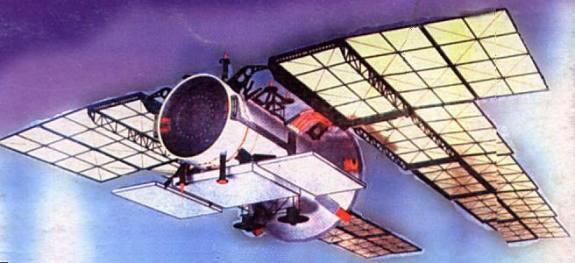
Home - Search - Browse - Alphabetic Index: 0- 1- 2- 3- 4- 5- 6- 7- 8- 9
A- B- C- D- E- F- G- H- I- J- K- L- M- N- O- P- Q- R- S- T- U- V- W- X- Y- Z
Pirs-2

Obzor
AKA: 17F120;US-PU. Status: Cancelled 1988. Gross mass: 6,500 kg (14,300 lb).
It would be launched by the Zenit-2 launch vehicle and was planned to achieve the Holy Grail of Soviet space systems - the detection of submerged US ballistic missile submarines. Design worked started in 1978 but development was protracted and a severe dispute raged regarding competing radar systems. The project was cancelled in 1988 when Gorbachev prohibited further development of deployment of nuclear-powered spacecraft.
The RLS active-radar spacecraft had the worst reliability and quality problems of any Soviet system. It was not available often enough for good exploitation of the data. Lessons learned during trials and first operational use resulted in a TTKh specification document for a modernized next generation system. A decree to begin design of this system was issued at the end of 1978. Specifications for the second-generation MKRTs system were developed co-operatively by TZ MO, VMP, GUKOS, and TsNII Kometa (Savin) in 1978-1980. Following approval by NTK and VPK, the development was to have begun in the Eleventh Five Year Plan (1981-1985). A resolution of June 1981 called for the Phase 2 Pirs-2 to start technical development in 1982. It was to provide double the capability of the Pirs-1 to observe ships, and potentially submerged submarines.
At the beginning of 1980 the Ministry of Defense upgraded KB Arsenal to KK Spacecraft Constructor status. KB Arsenal was made the Soviet Navy's sole source for naval reconnaissance systems and Ya F Valov was designated a Chief Designer of Space Systems.
The complete Ideogramma-Pirs system was to have been deployed during the Twelfth Five year plan (1986-1990). Development of the new design required cooperation between three OKB's due to use of the new Zenit launch vehicle: NPO Energia, PO Arsenal, and TsKBM. The systems technical specification was delivered to the VMF in September 1982.
Arsenal presented the draft project to the Military-Industrial Commission on 12 December 1982 after interagency review. Pirs-2 would test the experimental Farvater system with submarine detection capability. General Designer Yu F Valov at PO Arsenal was made responsible in 1983 for the overall space system, while TsNII Kometa solved detailed systems problems. Admiral Gorshkov fiercely resisted relinquishing Navy control of the system despite the desire of the leadership for consolidation of space systems. The overall space system specification was delivered to GUKOS in September 1983, followed by a combined technical proposal.
There were two competing radar systems, from the MRP and MOM industrial sectors. No decision was ever made on Phase 2 systems; the competing institutes were instructed to conduct further research to identify the best possible technical solution. A firm program schedule finally emerged in December 1984. Phase 2 was to be deployed by 1993. This decision also finally determined the work distribution between MRP and MOM.
In 1987 two experimental Plazma-A satellites (Cosmos 1818 and 1867) were launched with new-generation Topaz reactors. The spacecraft tested new on-board systems, new elements of the orientation system, and ion engines. Use of a new high radiation-safety orbit was also demonstrated. The Topaz used a new thermo-emission conversion method to convert heat to electricity. This would also power a range of new systems including electrostatic maneuvering engines, ion orientation / stabilization engines, solar sensors, magnetic momentum compensators, multi-channel wave devices, and special plasma weapons to provide a defense against anti-satellite weapons. The Plazma-A satellites carried instruments to map the magnetic field of the earth, with an eye toward developing a magnetic navigation system. Topaz provided over 10 kW of power and had long endurance and storage in a radiation-safe orbit. A follow-on Plazma-2 would have been equipped with the even safer Topaz-2. Despite these encouraging tests, the nuclear-powered component of the Pirs system was abandoned on the instructions of Gorbachev in 1988 due to continued reliability problems and international incidents when the reactor cores of the satellites crashed to the earth.
The Pirs-2 second phase active satellite was never launched. However the Obzor solar-powered civilian satellite marketed in the 1990's used the same space platform developed for the third generation MKRTs. The solar arrays provided only one tenth of the power that would have been generated by the Topaz reactor. Nevertheless, equipped with the Travers-A radar, built by OKB MEI (Moscow Energy Institute), a swath of 250 km would be observed with a resolution of 90 to 130 m, or a 50 km swath with a resolution of 6 to 12 m. New methods of on-board signal interpretation developed by the Institute of Space Geoinformation of the Russian Academy of Science (IKGI-RAEN), Saint Petersburg, would pass only significant data to earth for further processing. An operational Obzor system would consist of three 6.5 metric ton satellites flying in 524 km orbits inclined at 81.4 degrees to the equator. The Arsenal mid-class spacecraft bus had a mass of 4000 kg and could accommodate instrument payloads of up to 3000 kg. The bus had a three year design life. Pirs-2 would have had similar characteristics but even better radar swath and resolution characteristics with ten kW of power available.
Electric System: 10.00 average kW.
Family: Naval radarsat. Country: Russia. Agency: Arsenal. Bibliography: 102, 445.
Back to top of page
Home - Search - Browse - Alphabetic Index: 0- 1- 2- 3- 4- 5- 6- 7- 8- 9
A- B- C- D- E- F- G- H- I- J- K- L- M- N- O- P- Q- R- S- T- U- V- W- X- Y- Z
© 1997-2019 Mark Wade - Contact
© / Conditions for Use